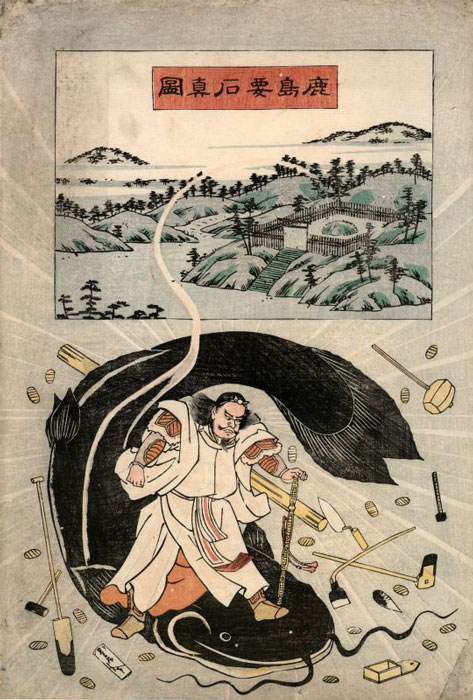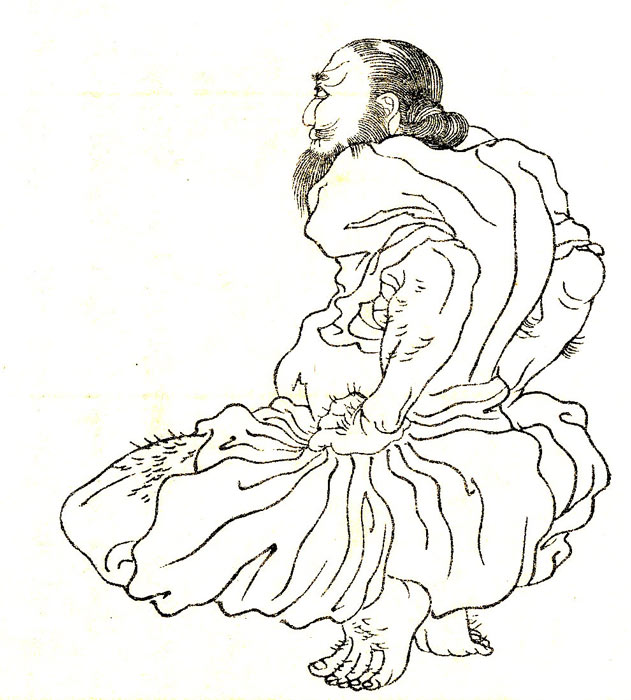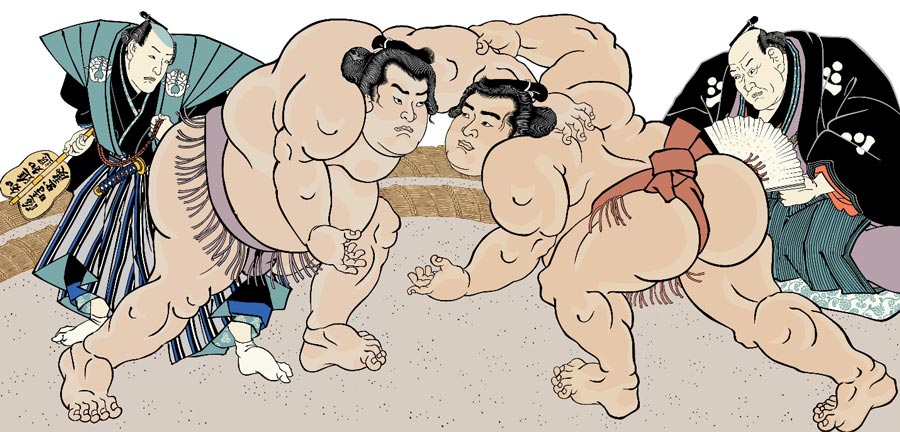Sumo Wrestling: From Ritual Origins to Honorable Sport
It is hard to think of Japan without sumo wrestling. This unique and very old sport has been one of the indivisible aspects of Japanese identity for over 1,500 years or more! Granted, sumo wrestling is a little strange and exotic: big, chunky, heavy men wearing “diapers” and grappling one another in a struggle that is challenging, tense, and honorable. It is without a doubt a one-of-a-kind sport, and the Japanese people simply love it! Over time, this love spread across the world, as it is now widely recognizable and equally popular outside of Japan. But one thing is even more interesting than the sport itself: its history. How did sumo wrestling begin? And, more importantly, when?

Though sumo wrestling is distinctly Japanese, wrestling in China also has a long history. This ancient Chinese belt plaque depicts two dismounted warriors wrestling, a martial arts practice that dates to about 4000 BC in China. (Daderot / CC0)
Did Sumo Wrestling Exist Outside of Japan?
Ask any Japanese person about sumo wrestling, and you will quickly get the generally accepted answer: “It’s a wholly Japanese sport.” And you can leave it at that, taking it for what it is. But history isn’t so simple. It’s like a tree, with roots spreading far back in time. And sumo wrestling is no exception.
Since it has been widely regarded as the most iconic national traditional Japanese sport, sumo can hardly be considered to have foreign origins. And true, to this day, no hard and deciding evidence has been found that would say that sumo isn’t Japanese. Still, some sporadic clues can tell us that the very earliest beginnings of wrestling were found across East Asia, particularly in China.
In recent archaeological excavations, researchers unearthed graves and tombs dating to the Qing dynasty and Han dynasty. Here, they found remains of stone walls that were adorned with paintings of wrestlers who resembled sumo wrestlers as they were topless and only wore a loincloth. Clay and stone figurines depicting topless wrestlers grappling one another were also discovered in ancient Chinese tombs dated to 5th and 3rd centuries BC. In fact, records of Shuai jiao wrestling in China have been dated to roughly 4,000 BC, which is over 6,000 years ago!
- Part II: The End Comes Slowly - The Last Han Dynasty Emperors
- The Origins of the Top 5 Most Ancient Martial Arts that are Still Practiced Today
In China, the sport of wrestling declined in popularity after the late Qing period (which ended in 1912), but in Japan its popularity grew over the centuries and it’s still growing. We can’t say for certain if Japanese sumo wrestling was influenced by Chinese wrestling. Wrestling was likely a warrior class sport in many Asian countries outside of Japan, as it was in ancient Egypt and Greece.
But some scholars believe or maintain that sumo came to Japan around the 200 BC, when the Chinese explorer and court sorcerer, Xu Fu landed on Japanese shores. Others propose that it was introduced during the Han dynasty (202 BC-220 AD) through Sino-Japanese relations. And then again, there are those that suggest that the sport arrived during the period of Three Kingdoms, when Chinese mercenary troops soldiered in Japan, fighting for feuding lords.

In Japanese mythology the thunder god Takemikazuchi, seen here riding a giant catfish, used a sumo wrestling match to decide which gods got the islands of Japan. The earliest recounting of this myth has been dated to 712 AD in a preserved manuscript. (Public domain)
Sumo Wrestling Origins: The Japanese Version
Japanese historical records indicate that sumo actually began as a ritual dance offering to the Japanese Shinto shrine gods with the hope of receiving bountiful harvests and ample rain. This was before Japanese had a writing system, which only arrived in the mid-6th century AD with Buddhism, followed by the Japanese hiragana script modeled on Sanskrit and Chinese characters.
Moreover, sumo can be found in Japanese origin mythology, which is also the story of the birth of the Shinto gods and the islands of Japan. The most iconic of these myths is about the thunder god Takemikazuchi. The earliest recounting of this myth can be dated to 712 AD in a manuscript. It describes in detail how the possession of the Japanese islands was decidedly won in a sumo wrestling match! The fighters were two deities (or spirits): Takeminakata, the god of wind, water, and agriculture; and Takemikazuchi, the god of conquest, sword and thunder. The latter won the match, thus winning the islands.

Nomi no Sukune, depicted here by Kikuchi Yōsai (1781-1878), is considered to be Japan’s first sumo wrestler! (Public domain)
In historical terms, the Japanese consider their traditional national sport to be at least 1,500 years old, which would place its origins in the period that led to the permanent Japanese capital of Asuka (538-710). The Nihongi or Nihon Shoki, written in 720 AD, Japan’s second-oldest book of classical history, tell us that sumo wrestling began in 23 BC, during the 7th year and the 7th month of the rule of Emperor Suinin, the 11th legendary emperor of Japan. This text tells of a legendary sumo wrestler, Nomi no Sukune, who fought a fateful match, to the death, against Taima no Kuehaya, winning in the end. Sukune is considered to be Japan’s first sumo wrestler. And don’t forget that until the Japanese Middle Ages, sumo wrestling matches were often fought to the death!
The first sumo match that can be positively dated as a historical event occurred in 642 AD, in the Asuka period, at the royal court of Empress Kōgyoku. It was conducted in order to entertain a visiting Korean delegation. And in the periods that followed, sumo became a popular sport and form of entertainment in the imperial court.
It was simultaneously entertainment and a manifestation of religious, ceremonial, and cultural significance. And we can safely assume that around this time it was no longer fought to the death. What is more, a set of clearly established rules was created, formalizing the sport during the aristocratic and elegant Heian period, which lasted from 794 to 1185 AD.

Over time sumo wrestling transitioned from a spiritual offering in Japanese shrines to a form of elite entertainment, a type of samurai combat training, and then a popular sport for the rising merchant class of Edo Japan. (Kmagazine)
A Series of Ups and Downs that Dictated the Fate of Sumo
However, with the collapse of the Kyoto-based emperor’s authority in 1185, and the emergence of the Kamakura Shogunate period that would last until 1333 AD, sumo wrestling entered a period of decline. During the Kamakura period, Japan was involved in intense conflicts, warfare, and numerous historic changes. Japanese society shifted towards a land-based economy, Japanese feudalism, and saw the emergence of the warrior caste known as the samurai.
Soon enough, as the tides turned, sumo wrestling was once more re-discovered and re-purposed, this time in a military role. It was utilized by the samurai as an efficient form of combat training and was considered a very useful form of increasing the efficiency of a warrior on the battlefield.
Around 1333, the Kamakura shogunate ended, and Japan entered the Muromachi period, lasting from 1336 to 1573 AD. And sumo wrestling was not forgotten. The tradition continued in earnest, and sumo wrestling matches were once again conducted, especially in temples and shrine compounds. It was a unique combination of religious and ceremonial practices and general sport entertainment for the elites and the fortunate, and the temple complexes found a way to benefit due to the donations of the visitors.
And the sumo wrestlers profited too, getting a share of the proceeds for their matches and for drawing the crowds. In many ways, this was the beginning of an accepted and organized sport. Many Japanese feudal lords, known as daimyō, would become sponsors of prominent sumo wrestlers and sumo schools, as they both enjoyed the sport and understood its importance and potential for income.
A sumo wrestler of prominence could even rise in the ranks if he was sponsored by a daimyō. If they fought for the lord’s favor and won, they received monetary favor and also the possibility of being awarded samurai status. One of the most prominent daimyō sumo fans and patrons was super warlord Oda Nobunaga.
In February of 1578 Nobunaga held a sumo wrestling tournament at Azuchi castle (one of the first “new” castles designed for musket warfare) in which 1,500 wrestlers participated. A special fighting area was developed for this occasion: a circular dohyō setting that defined the fighting boundaries for two wrestlers. A typical dohyō is a circle made of partially buried rice-straw bales 4.55 meters (15 feet) in diameter. The dohyō arena format was established by Nobunaga’s tournament and is today one of the important parts of sumo wrestling. In official professional sumo tournaments (honbasho), the dohyō is mounted on a square platform of clay, 66 centimeters (2.2 feet) high, and 6.7 meters (22 feet) wide on each side.

An early photograph of a sumo tournament or basho in Tokyo in the 1890s by an unknown photographer. (Public domain)
Loved by the People and Adored by the Feudal Lords
Still, sumo wrestling had a rocky and turbulent series of ups and downs over the centuries. It went from extreme reverence and popularity, to being banned and ostracized and then back again!
For example, in the Edo period (1603-1867) many sumo events were marred by violent public quarrels and brawls amongst the powerful samurai sumo patrons. Fighting often spilled out onto the streets, and sumo became increasingly chaotic.
This prompted the ruling Tokugawa government to issue a series of decrees that prohibited and banned sumo wrestling matches and performances. But even with the ban in effect, die-hard sumo fans could still enjoy the sport, as matches were still performed in secret, often on street corners or in temples.
Still, even if the fans were satisfied, the sumo wrestlers were not. The had transitioned from popular and patronized sportsmen to illegal brawlers on street corners, and that was not enough to make a good living.
The situation was saved when professional sumo schools (known as stables) began forming as groups centered on creating a set of standardized rules and regulations that could govern the sport and make it acceptable once again. Supervisors (similar to a judge or referee) were selected to enforce the rules, and in no time the sumo wrestling as we know it today was established as a spectator sport. Thanks to this, sanctions on the sport were lifted, and it once more became popular and established across Japan.
The first recognitions were made as early as 1684 in Tokyo, where an official blessing was given to the sport. Once again the best wrestlers could gain the patronage of powerful feudal lords and were backed by wealthy merchants. And once more they could rise to the rank of samurai, thanks to their wrestling skills.

A tori-kumi sumo wrestling match between yokozuna Asashōryū (left) and Komusubi Kotoshōgiku, in January 2008 in Tokyo. (Eckhard Pecher / CC BY 3.0)
Sumo: A Defining Element of Japanese History!
And sumo has remained a part of Japanese culture ever since. Sumo wrestling rules were improved over the decades, and special training schools arose across Japan, many of them still in existence. The iconic image of the near-naked and burly wrestlers was established as an unmistakable part of the Japanese identity and continues to be one to this day.
Of course, numerous legendary wrestlers and their feats and winning streaks came and went over the centuries. In more recent times, the record for the most consecutive victories is attributed to Futabayama Sadaji (1912-1968), with 69 wins in a row. And the title for the heaviest sumo wrestler ever goes to Orora Satoshi, who weighed more than 271 kilograms (close to 600 pounds!).
- Khutulun: The Undefeated Bad-Ass Mongolian Warrior Princess
- Newly deciphered papyrus reveals ancient Greek wrestling matches were fixed
Today, sumo wrestling is a widespread and recognized sport. Sumo “stables” (groups or schools) still continue their old-age traditions of training and regimental living. One of the major secrets of a wrestler’s strength is their weight and so they eat a lot! They are especially famous for eating “chanko nabe” regularly, which is a stew rich in meat, seafood, vegetables, and rice.
From the perspective of history, sumo wrestling is extremely interesting, as it was closely entwined with major Japanese historical transitions and provides clear insights into some of Japan’s key historical events.
Top image: Japan’s world-famous sumo wrestling has always been connected with its origins as a shrine spectacle offering to please the gods. With the rise of the Japanese merchant class in the 17th century sumo became the spectator sport it is today. Source: AQ-taro Images / Adobe Stock
References
Benjamin, D. 2011. Sumo: A Thinking Fan's Guide to Japan's National Sport. Tuttle Publishing.
Cartwright, M. 2017. Sumo. World History Encyclopedia. [Online] Available at: https://www.worldhistory.org/Sumo/
Kenji, E. 2020. The Rich History of Sumo Wrestling. Medium. [Online] Available at: https://historyofyesterday.com/understanding-the-ancient-sport-of-sumo-wrestling-18eacafc8d7c
Lee Choy, K. 1995. Japan: Between Myth and Reality. World Scientific.
Unknown. Sumo: The History & Rules of Japan’s National Sport. Japanistry. [Online] Available at: https://www.japanistry.com/sumo/

















